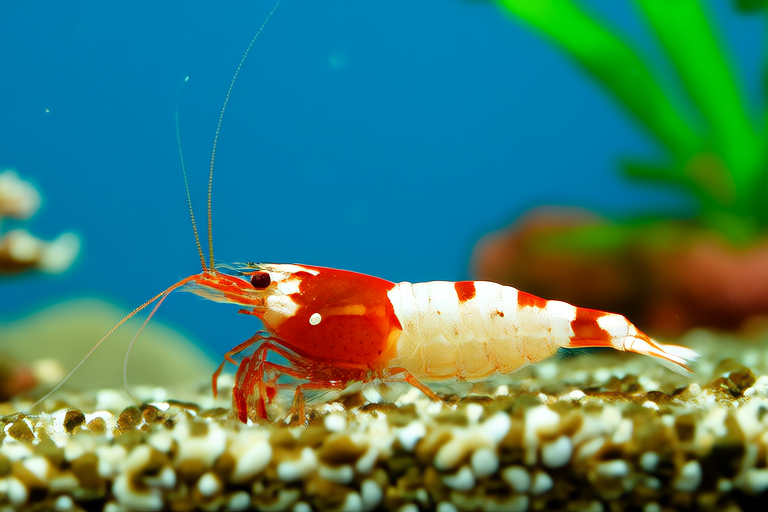The Complete Guide: Caring for Coral Shrimp Like a Pro
Coral shrimp (Caridina spp.) are popular additions to many saltwater aquariums, known for their vibrant colors and active behavior. Proper care of these delicate creatures requires attention to several key areas, including habitat setup, water parameters, diet, breeding, and health maintenance. This comprehensive guide aims to provide detailed information that will help both beginners and experienced aquarists successfully keep coral shrimp thriving in their tanks.
Habitat Setup
Creating an ideal environment for coral shrimp involves replicating their natural habitat as closely as possible. Start by selecting a suitable tank size; while small groups can be housed in nano tanks, larger populations benefit from more spacious environments. A minimum volume of 10 gallons per 10 shrimp is recommended to ensure adequate space for swimming and exploration.
Substrate choice plays a crucial role in mimicking the reef structure found in nature. Fine sand or crushed coral serves well due to its similarity to the substrate found on reefs. Avoid sharp-edged materials which could injure your shrimp.
Decorations such as live rock and various types of corals not only enhance aesthetics but also offer hiding spots and surfaces for algae growth – a primary food source for many species of coral shrimp. Ensure ample coverage with these elements so each shrimp has access to numerous safe spaces.

Water Parameters
Maintaining optimal water conditions is vital for the health of coral shrimp. Regular monitoring of salinity, pH levels, temperature, and ammonia/nitrite levels ensures they remain within acceptable ranges. Salinity should be kept between 1.020 and 1.025 specific gravity; pH between 8.1 and 8.4; temperatures around 72-78°F (22-26°C); and zero detectable levels of ammonia and nitrite.
Water changes are necessary to maintain cleanliness and replenish essential minerals lost over time. Perform partial water exchanges every two weeks, changing approximately 10% of the total volume each session. Use a high-quality dechlorinator when adding new water to neutralize harmful chemicals present in tap supplies.
Diet
Feeding coral shrimp correctly supports their overall wellbeing. Their diet consists mainly of algae, detritus, and microorganisms found naturally in seawater. In captivity, you can supplement this with commercial foods designed specifically for invertebrates or flakes intended for marine fish.
To encourage natural feeding behaviors, incorporate algae wafers or dried seaweed into feedings. Additionally, consider enriching the tank with biofilm – a layer of microscopic organisms that develops on submerged surfaces under proper lighting conditions.
Overfeeding poses risks to water quality, so monitor how much food your shrimp consume during each meal. Remove any uneaten portions after five minutes to prevent pollution.
Breeding
Breeding coral shrimp presents unique challenges and rewards. Successful reproduction requires specific environmental factors, including stable water parameters, abundant hiding places, and sufficient dietary nutrients.
Females carrying eggs exhibit distinct coloration patterns, signaling readiness for spawning. Males display courtship rituals involving intricate dances aimed at attracting partners. Once fertilized, eggs undergo development stages before hatching into larvae.
Larval rearing demands specialized setups equipped with appropriate lighting, filtration systems, and constant monitoring of water quality. Newly hatched larvae require brine shrimp nauplii as their first food source until they develop into juvenile shrimp capable of consuming adult diets.

Common Health Issues
Despite best efforts, coral shrimp may encounter health problems. Some common ailments include bacterial infections, parasitic infestations, and stress-related disorders.
- Bacterial Infections: Characterized by cloudy eyes, lethargy, and abnormal swimming patterns. Treatments involve antibiotics prescribed by a veterinarian specializing in aquatic animals.
- Parasitic Infestations: Often manifest through external parasites visible on the body surface. Quarantine affected individuals immediately and treat with antiparasitic medications.
- Stress-Related Disorders: Caused by sudden changes in water chemistry, overcrowding, or aggressive tankmates. Address underlying causes promptly to alleviate symptoms.
Regular observation allows early detection of potential issues, increasing chances of successful treatment. Establish a routine check-up schedule to monitor the condition of all inhabitants regularly.
Tips for Maintaining a Healthy Shrimp Population
Several strategies promote long-term success in caring for coral shrimp:
- Quarantine New Arrivals: Isolate newly acquired specimens for at least four weeks to prevent introducing diseases into established communities.
- Monitor Water Quality: Invest in reliable testing kits and establish regular schedules for checking critical parameters.
- Provide Adequate Hiding Spaces: Ensure sufficient shelters throughout the tank to reduce stress levels among residents.
- Limit Aggressive Tankmates: Choose compatible companions who pose minimal threat to smaller inhabitants.
- Encourage Natural Feeding Behaviors: Introduce live plants, algae wafers, and other organic matter to stimulate natural foraging activities.
By implementing these practices consistently, aquarists create favorable conditions conducive to longevity and prosperity within their shrimp colonies.
Conclusion
Properly caring for coral shrimp involves understanding their needs and providing an environment that mimics their natural habitats. Through careful consideration of habitat setup, diligent maintenance of water parameters, thoughtful dietary planning, attention to breeding cycles, awareness of common health issues, and adherence to beneficial tips, enthusiasts can enjoy vibrant, thriving populations of these captivating creatures. With patience and dedication, even novice aquarists can become experts in cultivating healthy, happy coral shrimp.
